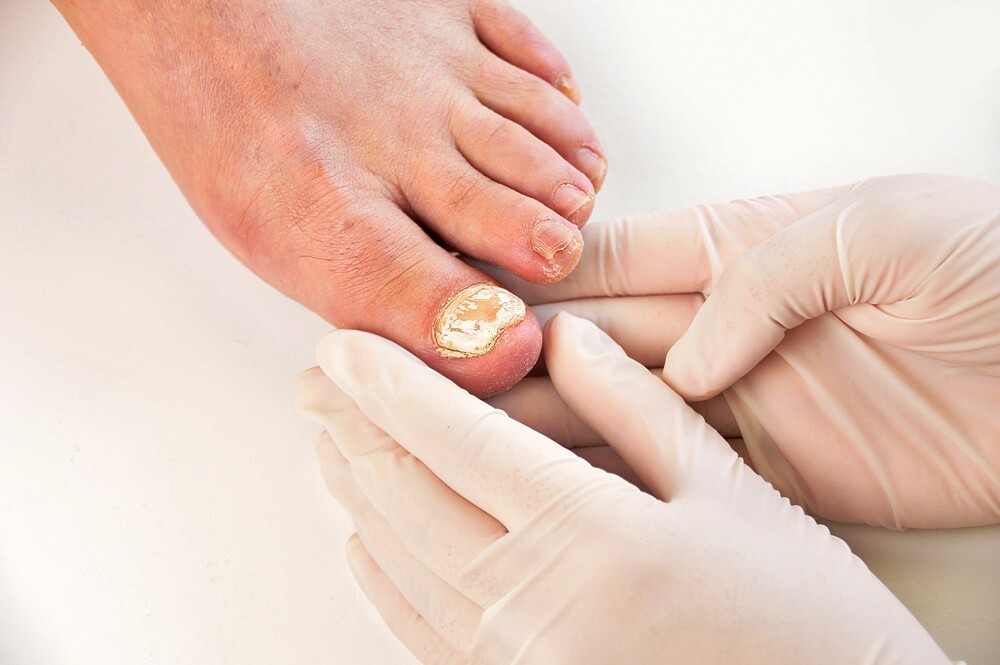Nail fungus is an extremely unpleasant and persistent disease that can occur on the toenails and fingernails. We will explain to you how to prevent nail fungus and which remedies help with the fungal infection.
What is nail fungus?
In the case of a fungal infection, the nails on fingers and toes may be diseased. In this case it is a nail fungus (medical: onychymocosis). Mostly thread fungi, the so-called dermatophytes, are responsible for the infection. In rare cases, mould or yeast fungi trigger the fungus.
The nail bed is usually affected – which can lead to the nail becoming detached in advanced onychymocosis. The fungal infection often begins with a brownish discoloration of the nail on the sides.
Foot fungus as a trigger?
As fungi feel particularly comfortable in damp environments, toenails are more often affected than fingernails. Nail fungus often develops as a result of a mycosis pedis infection, as the same pathogen is responsible for both diseases. The fungus then spreads from the spaces between the toes to the nail of the big toe.
If the toenail fungus is treated immediately, it cannot develop further. However, if the aggressive fungus is not treated directly, it can spread to all other toenails. The nails can be completely destroyed if no treatment is given, which is accompanied by considerable pain.
Symptoms: How to recognize nail fungus
The dermatophytes usually nest first at the upper edge of the nail. From there they start to infest the entire nail. The nail fungus destroys the keratin, which is responsible for the solid substance of the nails. This causes air bubbles to form and the toenail becomes porous. It also swells and turns white to yellowish.
Yeast fungi spread from the nail wall, i.e. from where the nail grows out of the foot. The nail plate then becomes brittle and can even lift itself off the skin. However, you should always consult a doctor for a diagnosis.
Treatment of the fungal disease
In case of light nail mycosis you can treat the disease with creams and transparent nail polishes with the anti-fungal agents Ciclopirox, Amorolfin or Bifonazole, which you can get over the counter at the pharmacy.
Anti-fungal varnish is available in water-soluble and waterproof versions. It is sufficient to apply it once a day (pharmacists recommend in the evening).
However, there are also nail sets that promise success in a few weeks, as they can penetrate deeper into the nail bed. They consist of a combination of ointment, plasters and a spatula for scraping. And this is how the combined application works:
- Apply a thin layer of the ointment to the affected nail areas.
- Then mask with one of the plasters and leave on for 24 hours.
- Remove the patch and carefully scrape off the softened nail areas with a spatula.
- Use daily for two weeks.
- Then apply the ointment daily for another four weeks.
If the fungal infection is already more advanced, you should take the active ingredient in tablet form, as the fungus must then also be combated from the inside via the blood. The family doctor will then prescribe a remedy against onychomycosis.
A nail fungus infection takes…
Patience is required during therapy because the fungus is very tough. If a nail is infected, it can take several months before the active ingredient has completely destroyed it.
By the way, medical pedicure or a podiatrist who can professionally treat a nail fungus infection and assess which nail layers of the nail plate are already affected by the fungal disease, also offers good help.
Home remedies: Apple cider vinegar and tea tree oil against nail fungus?
Although general medicine is sceptical about alternative forms of therapy, some home remedies have proven to be effective. If you suffer from a mild fungal infection, you can try to alleviate the symptoms with a footbath made of apple vinegar. Simply put vinegar and water in the same proportion in a container and bathe your feet for ten minutes. Alternatively, you can apply the vinegar to the affected areas with a cotton swab. Since fungi do not like an acidic environment, they should be eliminated by the acid.
The substances in tea tree oil are also said to be able to combat fungal infestation. Simply dab the nail fungus with the oil. It is also possible to mix a few drops with water and also take a foot bath.
Important: Towels, bath mats and socks should be washed frequently and at 60 degrees if you have a nail fungus infection, because the fungal spores of the filamentous fungi (dermatophytes) can spread quickly and infect others.
Prevention: So you can protect yourself from nail diseases
If you want to prevent nail fungus, you should especially make sure that your feet are not damp. It is important to dry your feet properly after swimming and showering and not to neglect the space between your toes.
Comfortable and airy shoes made of air-permeable materials provide a pleasant climate and prevent sweaty feet, which promote nail fungus. Fingernail fungus is therefore also less common, as the hands are always exposed to the air. If you go to the sauna and/or swimming pool, you should always wear flip-flops.

